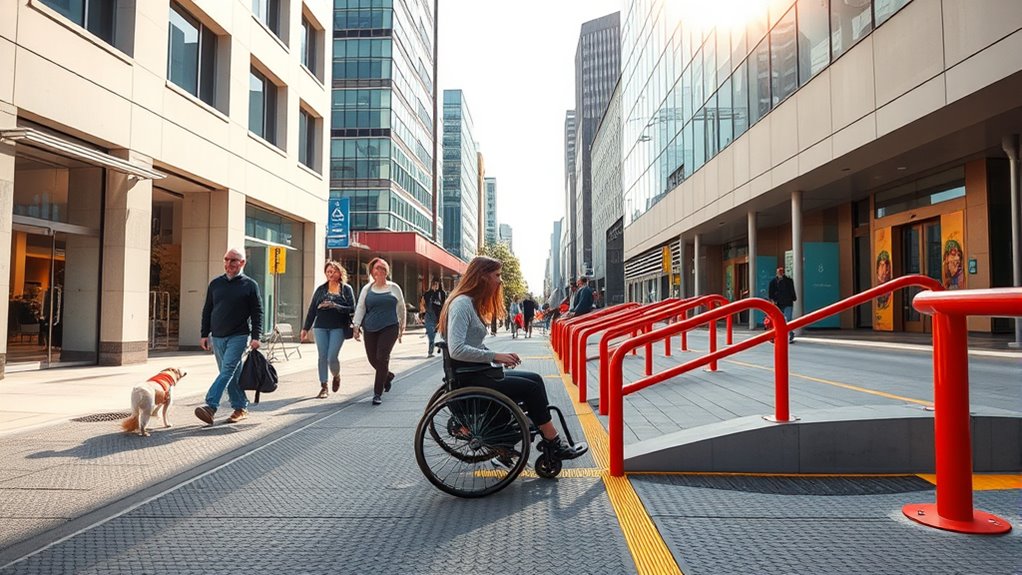Designing accessible by default means you embed inclusivity into every step from the start, ensuring your spaces and products serve everyone. By prioritizing accessibility early, you avoid costly retrofits later and create experiences that are intuitive, flexible, and welcoming for diverse needs. This approach fosters equity, broadens your reach, and demonstrates social responsibility. If you keep exploring, you’ll discover how universal usability benefits all users and transforms how you approach design.
Key Takeaways
- Integrate accessibility into the initial design process to prevent costly modifications and ensure inclusive environments from the start.
- Prioritize universal usability by incorporating flexible features that accommodate diverse needs and preferences.
- Leverage assistive technologies seamlessly within designs to enhance digital accessibility for all users.
- Embed accessibility principles early to foster equitable, human-centered experiences that benefit everyone.
- Recognize accessibility as a strategic commitment that broadens reach, improves engagement, and demonstrates social responsibility.

Have you ever considered how design can be inclusive for everyone? When you prioritize accessibility from the start, you create environments and products that serve a broader range of needs. This approach isn’t just about adding features later—it’s about embedding inclusivity into the foundation of your designs. Assistive technologies play an essential role here, acting as tools that help individuals with disabilities navigate digital spaces comfortably. Screen readers, voice recognition software, and alternative input devices transform how users interact with websites and apps, guaranteeing they’re not left behind. By integrating these technologies seamlessly, you’re fostering an experience rooted in universal usability—design that works well for the widest possible audience, regardless of their abilities or limitations. Incorporating performance cookies can also help identify areas where accessibility improvements are needed. Designing with accessibility in mind means thinking about all users from the outset. It involves more than just complying with legal standards; it’s about recognizing that good design benefits everyone. For example, captions on videos help not only those with hearing impairments but also users in noisy environments or those who prefer reading over listening. Clear, simple navigation benefits people with cognitive disabilities and busy users alike. When you adopt this mindset, you eliminate barriers that might otherwise exclude some users. The goal is to create a digital or physical space where assistive technologies can easily connect with the design, making interactions intuitive and effortless. Universal usability is your guiding principle here. It demands that you design for flexibility and adaptability, anticipating various needs and preferences. This means offering multiple ways to access content—such as keyboard navigation in addition to mouse control or adjustable font sizes and color schemes. When you embed accessibility into your design process, you’re not just making it compliant; you’re making it better for everyone. It’s about creating solutions that are inherently inclusive, so no user feels marginalized or frustrated. This proactive approach minimizes the need for retrofitting or costly modifications later. Ultimately, designing accessible by default transforms how people experience your work. It demonstrates respect for diverse abilities and promotes equity. By leveraging assistive technologies and aiming for universal usability, you ensure that your designs are truly inclusive, welcoming everyone to engage fully. Making inclusion non-negotiable isn’t just a moral or legal obligation; it’s a strategic choice that elevates your work and broadens your reach. When accessibility is woven into your design process from the beginning, you craft experiences that are more meaningful, effective, and human-centered—benefiting all users in the process.
Frequently Asked Questions
How Can Small Businesses Implement Accessible Design Affordably?
You can implement accessible design affordably by adopting cost-effective strategies like using free or low-cost accessibility tools and resources. Focus on simple, inclusive features such as clear navigation, readable fonts, and descriptive alt text for images. Prioritize accessibility early in your design process to avoid costly retrofits later. Collaborate with community members for feedback, ensuring your solutions meet diverse needs without exceeding your budget. This approach makes inclusion a natural, affordable part of your business growth.
What Are Common Misconceptions About Accessible Design?
You might think accessible design is just about adding features later, but it’s actually essential from the start. A common misconception is that color contrast or assistive technologies are optional, yet 15% of the global population has some disability. Proper color contrast guarantees readability, and assistive technologies enable inclusive access. By integrating these from the beginning, you create a more equitable experience without costly retrofits, making your business truly accessible.
How Does Accessible Design Impact Overall User Experience?
Accessible design greatly enhances your overall user experience by ensuring everyone can navigate and interact effortlessly. When you incorporate usability testing and monitor accessibility metrics, you identify barriers and optimize for inclusivity. This not only broadens your audience but also creates a seamless, enjoyable experience for all users, regardless of ability. Ultimately, accessible design fosters loyalty and satisfaction, making your digital products more effective and equitable.
What Legal Requirements Exist for Accessible Digital Content?
Imagine you’re designing a website, and a client insists on legal compliance. You must follow accessibility standards like WCAG 2.1 to guarantee your content is inclusive. Laws such as the ADA and Section 508 require digital content to be accessible to people with disabilities. Non-compliance can lead to lawsuits and penalties, so making accessibility a priority isn’t just ethical—it’s legally essential.
How Can Designers Ensure Accessibility Across Multiple Devices?
To guarantee accessibility across multiple devices, you should implement responsive layouts that adapt seamlessly to different screen sizes and orientations. Focus on cross-platform compatibility by testing your design on various devices and operating systems, ensuring that all users can navigate and interact effortlessly. Use flexible images, scalable fonts, and accessible controls, so your content remains usable and inclusive, regardless of the device your audience is using.
Conclusion
You might think making design accessible is too complicated or time-consuming, but it’s worth it. Prioritizing inclusion from the start saves you effort down the line and reaches more people. Remember, accessible design isn’t just a checkbox; it’s about creating experiences everyone can enjoy. When you make accessibility a default, you’re not just complying—you’re building a more inclusive world. So, why wait? Start now, and make inclusivity your standard.








